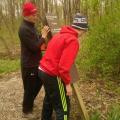Thanks to Eagle Scout candidate Quinn Retzloff, we have new and improved signs in the nature preserve. The old signs were well-worn, to put it mildly, and in one instance referred to a trail we removed for restoration. The new signs will support a much-improved visitor experience.
MEEC maintains two miles of walking trails through the front meadow, prairie and woods. Our trail guide allows visitors look deeper into these ecosystems and the plants and animals that live on the property. Our resource center also houses a great number of field guides you can use on-site to identify plants and animals you encounter. Use the interactive map or download the trail guide PDF below.





![By Jim McCulloch (Flickr: Chimney swift overhead) [CC BY 2.0]](https://meec.center/files/styles/thumbnail/public/field/image/Chimney_swift_overhead.jpeg)